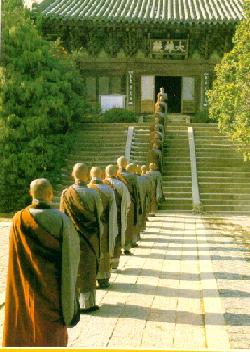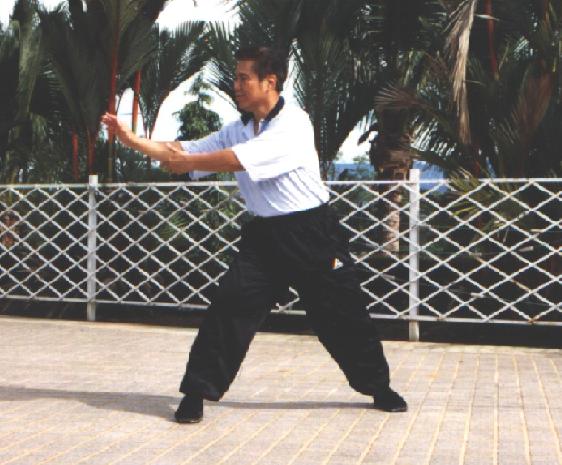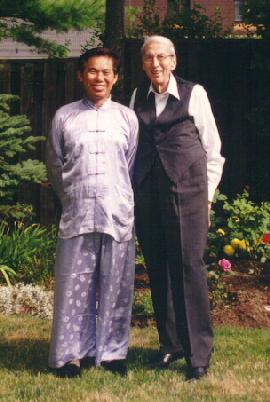SELECTION OF QUESTIONS AND ANSWERS
JULY 1999 PART 1

Zen monks in quest of enlightenment
Question 1
My experience with Kungfu began only two months ago at a school here in Denver. The instructors are both “7th Level Senior Masters”, Master David and Master Sharon Soard. So far, I have been very pleased with the training overall, but do not have anything to measure it against.
— Ben, USA
Answer
A good point of reference is the classical texts on Shaolin Kungfu. Compare what you have learnt with what Shaolin Kungfu is as described in the classics.
Question 2
We do learn many fundamentals of kicks and punches, stances and forms, and sparring, with an emphasis on the reality of street defense. However, they constantly stress the true scope of the endeavor we are embarked upon, and the philosopy that what we learn, in terms of the ability to fight, serves to teach us that true victory is living a life of peace and health, and that we hopefully would never need to use the Kungfu that we learn.
Answer
This (the above) is true Shaolin philosophy. A Shaolin disciple is confident and proud of his learning, but he never boasts of it to others. He hopes never to use his kungfu in combat, but if he has to, he would use it well according to the spirit of Shaolin, which includes not hurting an opponent unnecessarily.
On the other hand, he puts his kungfu to full use in his work and play. Not only his kungfu training makes him agile, alert and relaxed at all times, he also applies his kungfu principles to his daily life. For example, when he walks along a street, he makes sure that passing traffic would not hit him accidentally. When he plays a game that will last half an hour, he will space his energy output so that he can complete the game satisfactorily.
So, if you are in a subway station next time and see a person walking at the edge of a platform — even when a train is not approaching yet; or when you find a player panting after five minutes of a thirty-minute game, you can safely conclude that they are not trained in Shaolin principles.
Question 3
The model or “true” Kungfu warrior seems to be the goal of utilizing with the utmost effciency, insight, timing, and spiritual awareness in life, and if needed, in fighting. The black-belts that I practice with on occasion seem to just “be”, and never where I punch or kick, and never break a sweat in sparring (so it appears), and never look like children, they move with such grace it sometimes scares me.
Answer
You are right. The black-belts are well trained; they are combat efficient at all times, and in a relaxed, graceful manner. They need not spend time warming up, nor are they tensed and screaming when attacking or being attacked.
Question 4
It appears that what they have to offer in fighting is very effective, but has nothing of the blunt, power aspects of the “children's fighting” that you talk about. However, I am so new, I know that I can't see too deeply into it.
Answer
Your senior classmates and teachers are perfect models for other martial artists to follow. You would appreciate them even more, if you have seen how most other martial artists spar — many of them, especially inappropriately trained kungfu students, actually spar like children fighting. Your seniors and teachers are living examples of what proper Shaolin training produces.
Question 5
Do you know anything about this school, the “Chinese Shao-lin Center” in Denver. I have some criticisms of some aspects of the school, but it seems that they espouse both the practices and philosopy found in your web page.
Answer
You are lucky to learn and practise in this very good Shaolin school, the Chinese Shao-lin Center of Denver. You have been in the school for only two months, yet you have been exposed to such fine teaching. Honour and treasure your school and teachers, and live up to its fine tradition. You can be sure that it is not easy to find such a school anywhere in the world.
Sometimes criticisms are the result of a shallow perspective. For example, a teacher may be strict in his discipline, and asks late comers to wash the toilets. To those used to the liberal attitude of modern American youths, such an action is barbaric and totalitalian. But from a deeper perspective of a traditional master, such discipline is necessary to ensure good result in the training.
Many American youths have expressed to me their desire to become Shaolin monks. They probably did not know that Shaolin monks, according to genuine Buddhist tradition, have to follow over 400 strict rules. A monk, for example, cannot listen to rock music or sleep on a comfortable bed. Incidentally, if you find Shaolin monks wearing wigs or drinking Coca Cola, you can suspect whether they are real Shaolin monks.
Asspiring American youths may, in their own right, criticize these rules. What they did not know is that these rules were formulated by the Buddha, the Enlightened One, in his great compassion to help others attain enlightenment. The Buddha and Buddhists have nothing against listening to rock music, sleeping on comfortable beds, wearing wigs and drinking Coca Cola — indeed many good Buddhists do these things — but if one wants to be a monk he has to forego them, because they are hinderance on his chosen path to his highest attainment.
What have listening to rock music and sleeping on comfortable beds anything to do with attaining the highest spiritual cultivation, you may ask. Let us take a rough analogy. Suppose you are preparing for an important examination. You may like watching television, but you would turn off the television so that you can concentrate on your studies.
If a monk feels he is incapable or not ready to meet the demanding requirements, he is free to leave monkhood. In the Shaolin tradition, leaving monkhood represents the greatest disappointment to the person invloved; it indicates his admission of defeat in his pursue of the highest spiritual cultivation.

Taijiquan by itself is chi kung. In other words, if you practice genuine Taijiquan, there is no need to borrow chi kung exercises from elsewhere. But if you practice Taiji dance, then it is just gentle physical exercise.
Question 6
My teacher learned the art within the Shaolin Temple in Mexico City and is a Taoist Monk. Or at least that is what I came to believe in the 8 years that I served as his apprentice.
— Stephanie, USA
Answer
I do not know about the Shaolin Temple in Mexico City. Perhaps it was built by someone inspired by the Shaolin tradition, but I wonder whether it has any connection with the Shaolin Temple in China.
The Shaolin Temple is unquestionably Buddhist; hence, it is odd that your teacher who learned in the Mexican Shaolin Temple is a Taoist monk. But this may be possible because throughout history people of various religions studied in the Shaolin Temple in China.
For example, Zhang San Feng, who was already a Taoist priest and later the founder of Tai Chi Chuan, studied in the Shaolin Temple in the 13th century. But if someone told me that he went to study in a (any) Shaolin Temple and consequently became a Taoist monk there, I would suspect — either the temple or the person was fraudulent.Question 7
But now, I have become a student of a master from Hong Kong and he has instilled some doubt about the credibility of my former master. This hurts me very much as I treasure the forms and meditations that I have practiced for years.
Answer
What is important is whether your forms and meditations are useful. If they are, it does not matter much whether they are really from Shaolin. If they were not genuinely Shaolin, you could coin a new term for them.
Question 8
Now, I feel an aversion toward them because my second master criticizes their worth, in favor of the Chen Tai Chi Chuan that he passes to me.
Answer
Generally it is unethical for one master to criticize another master or another style. But sometimes it may be permissible if, for example, he does so in sincerity to help you realize that what you thought was genuine Shaolin arts and of high value were actually fraudulent and quite inferior.
Question 9
How can I authenticate the Shaolin association of my first master?
Answer
You can evaluate with reference to three factors: lineage, philosophy and forms. Check whether the Mexican association has an authentic link with the Shaolin Temple in China or with genuine Shaolin tradition. Next, compare the philosophy of this association with that of traditional Shaolin. Thirdly, examine whether the forms are the same as those illustrated in classical Shaolin texts.
Question 10
Since I now study with my second master should I leave behind what I learned as Shaolin tradition?
Answer
You should compare the two and choose the better one. Should you find your former style better, you would then spend more time on it, irrespective of whether it is genuinely Shaolin. But whatever you choose, always respect your teachers even if you later become better than them.
Question 11
I'm seeking very important information regarding myself entering monkhood in a Shaolin Temple in China. I am earnestly looking for a very traditional, holy temple that maintains a low-profile, is secluded away from modern distractions. I'm very dedicated to the life of Buddhism/Taoism. I would also like to supplement my training with ch'i-kung. I want to study Kung-Fu not as a combat sport but as a form of spiritual training, so I need a master competent in both of the disciplines.
— Kevin, USA
Answer
Entering monkhood is an exceedingly noble but decisive decision; you have to consider very carefully.
If after very careful consideration, you are sure you want to become a monk, I would suggest that you fly to China (with sufficient money) and spend at least three months travelling all over the country to earnestly seek the master and temple you have in mind. It is most likely that such a master and temple would be located in a very remote place, far from the noise of tourist centres and everyday civilizattion.
Read some good books on Buddhism. You may find my book, “The Complete Book of Zen” useful. Meanwhile, practise even while you are still a lay person what a true monk would practise. The three principal tenets of Buddhism are avoiding all evil, doing good and cultivating the mind.
The two pillars of Mahayana monkhood are compassion and wisdom. Compassion can be readily realized through avoiding all evil and doing good, while wisdom realized through meditation. Wisdom here is not just ordinary everyday wisdom, but cosmic wisdom, i.e. the understanding and hopefully the eventual realization of ultimate cosmic reality.
At 89, Robert Trout is an inspiration for us. He is not only physically healthy, emotionally calm and mentally fresh, but also has a keen sense of humour and carries a boyish twinkle in his eyes. There is another thing very special about him. As a senior reporter with the ABC, Robert has interviewed all the American presidents from Presient Roosevelt to President Clinton!
Question 12
I am training Aikido and Wing Chun seperately for different purposes.
— Janowskis, New Zealand
Answer
If you have invested much time in any one or both of them, it would be better to stick to them. Otherwise, you may consider changing into just one style, which may or may not be Aikido or Wing Chun, so that your time spent will be more cost-effective.
Personally, I would chose Shaolin Kungfu because, besides providing benefits that both Aikido and Wing Chun provide, it has rewards that these two arts do not normally provide, such as mind expansion and spiritual joy. But it is important that you learn from a real Shaolin master.Question 13
Does the Sil Lum Tao form have an energy training component or is it purely on the level of form? Can I martial and direct energy using the Sil Lum Tao form?
Answer
In Choe Family Wing Choon that I practiced, the form or set is called "Siu Lin Tou", and not "Sil Lum Tao".
The Siu Lin Tou set has an energy training component taught to selected disciples. This energy training component is intrinsic, i.e. by practising Siu Lin Tou in a certain way, without the need to use apparatus or to do supplementary exercises, the practitioner can develop internal force.Having been trained in this way, the practitioner can effectively martial and direct energy for combat or other purposes. However, the Sil Lum Tao set I generally see elsewhere is purely on the level of physical form.
It may be that the masters in these other Wing Choon styles have kept the energy training component secret too; in the Choe Family Wing Choon that I have been trained in, only a very few people know about the energy training component in Siu Lin Tou, most others perform the set on a purely physical level.Question 14
Is it true that Shaolin chi kung focuses first on external chi and then, when the practictioner gets older, internal? I ask this because from what I know, if a person focuses on just wai dan chi, he will risk energy dispersion when he gets old, while on the other hand, nei dan doesn't have that risk.
Answer
No, your concepts are not true for Shaolin Chi Kung as a whole. Shaolin Chi Kung is probably the most extensive as well as most profound school of chi kung with numerous types. Even just the one type of Shaolin Chi Kung I practise, which is Shaolin Cosmos Chi Kung, is so extensive and profound that an exponent can readily choose an appropriate chi kung exercise to suit his purpose of focussing on his external or internal chi.
External and internal chi, or waidan and neidan, are relative. A skillful exponent in Shaolin Chi Kung can convert external to internal chi, and vice versa, easily. It is only in lower level chi kung that the difference between waidan and neidan is important, and where, as you rightly mentioned, that sololy focussing on waidan without developing neidan may result in the practitioner's energy dispersing when he ages.
In my opinion, it is also the reason why students of waidankung, or art of external energy, have to release their energy at the end of each practice so as to avoid their energy acumulating into neidan, or internal energy, which they have not learnt to control.But what you said may be true for many people who do not have the opportunity to go deeper in Shaolin training. Many Shaolin exponents only train in external chi. In Shaolin terms, this external chi training is usually not called waidan, but called hard chi kung. A good example of hard chi kung is Iron Shirt. An Iron Shirt exponent, if he does not also train internally, may loose his external chi when he gets old.
Question 15
What about Tai Chi Chuan? Does it have any external chi development in it?
Answer
Tai Chi Chi Kung is a high level chi kung. Performing a Tai Chi Chuan set properly leads to the development of external chi. Abdominal Breathing develops internal chi. The Three-Circle Stance develops both internal and external chi.
When a Tai Chi Chuan master strikes an opponent, he converts his internal chi to external chi for the strike. On the other hand, Tai Chi dance, though graceful and elegant, has neither external nor internal chi development.Question 16
You have also mentioned Robert Trout as your oldest student who has learnt Shaolin kung fu from you. Does he practice any wai dan sets or only nei dan, or both?
Answer
Robert Trout, who was 89 when he first learnt Shaolin Kungfu from me, is probably the oldest person in the world to start martial art training. He is not only physically healthy, emotionally calm and mentally alert, but also has a keen sense of humour and stills carries a boyish twinkle in his eyes. He is an inspiration for us, especially those who think they are too old to practise chi kung.
Like any other student practising genuine Shaolin Kungfu, Robert develops both external and internal chi. Actually the terms waidan and neidan, which are Taoist terms, are not often used in Shaolin training, because as it involves both external and internal training of energy it does not pay much attention to this academic difference.
